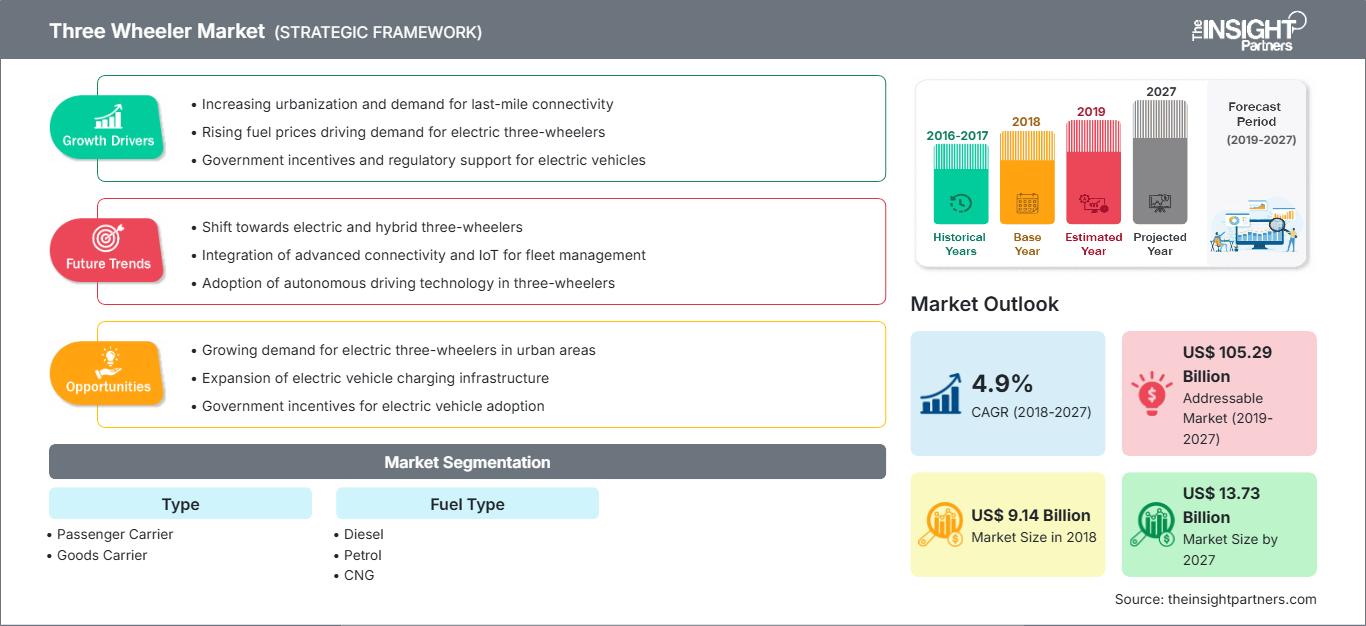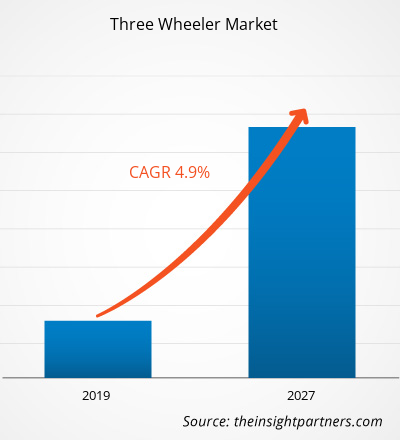El mercado de vehículos de tres ruedas se valoró en 9.140 millones de dólares estadounidenses en 2018 y se espera que crezca a una tasa de crecimiento anual compuesta (TCAC) del 4,9% entre 2019 y 2027, hasta alcanzar los 13.730 millones de dólares estadounidenses en 2027.
Los mototaxis son vehículos de tres ruedas utilizados para el transporte de pasajeros. Pueden transportar entre tres y seis pasajeros. En zonas rurales, según las necesidades, pueden viajar más de seis pasajeros. El mototaxi eléctrico es uno de los principales tipos de mototaxis. Funciona con baterías, es ecológico y produce menos emisiones y ruido que los mototaxis convencionales. Los mototaxis eléctricos pueden transportar entre cinco y seis pasajeros. La creciente demanda de mototaxis eléctricos, el aumento de la población y la necesidad de vehículos que ayuden a descongestionar el tráfico en la región han impulsado el crecimiento del mercado global de mototaxis. En 2018, la región de Asia-Pacífico ocupó una posición destacada en el mercado de mototaxis durante el período de pronóstico. Se prevé que países como India dominen el mercado nacional y de exportación durante dicho período. Además, muchos fabricantes consolidados de la India se están centrando en la producción de vehículos de tres ruedas que cumplen con la normativa BS (Bharat Stage) VI, la cual se implementará en 2020 para controlar las emisiones de partículas, óxidos de nitrógeno y azufre. Se observa un crecimiento significativo en China, seguida de otros países asiáticos como Tailandia y Malasia, debido a la creciente necesidad de medios de transporte en las zonas rurales y semiurbanas del país y al aumento de la población.
Obtendrá personalización gratuita de cualquier informe, incluyendo partes de este informe, análisis a nivel de país y paquetes de datos de Excel. Además, podrá aprovechar excelentes ofertas y descuentos para empresas emergentes y universidades.
Mercado de vehículos de tres ruedas: Perspectivas estratégicas

-
Obtenga las principales tendencias clave del mercado que se describen en este informe.Esta muestra GRATUITA incluirá análisis de datos, que abarcarán desde tendencias de mercado hasta estimaciones y pronósticos.
Perspectivas del mercado
La creciente demanda de vehículos de tres ruedas ecológicos está impulsando el crecimiento del mercado.
La industria automotriz mundial experimenta un aumento constante en el número de nuevos fabricantes de vehículos de tres ruedas. Estos fabricantes siguen de cerca el desarrollo del segmento de vehículos eléctricos, ya que este sector despierta el interés de los consumidores a nivel global. La industria automotriz mundial está experimentando una importante transición de los vehículos tradicionales de tres ruedas a los eléctricos.
Los gobiernos de varios países están tomando la iniciativa para la adopción de vehículos eléctricos de tres ruedas. Por ejemplo, en marzo de 2018, el Ministerio de Industrias Pesadas y Empresas Públicas de la India lanzó la Fase II del programa FAME India, que se inició el 1 de abril de 2019 y tendrá una duración de tres años, con un presupuesto total de 1390 millones de dólares estadounidenses. Esta fase se lanzó principalmente para apoyar la electrificación del transporte público y compartido, y tiene como objetivo subvencionar 7000 autobuses eléctricos, 500 000 vehículos eléctricos de tres ruedas, 55 000 automóviles eléctricos de cuatro ruedas y 1 millón de motocicletas eléctricas. Esta fase del programa FAME busca establecer una infraestructura de carga pública adecuada para generar confianza entre los usuarios de vehículos eléctricos. Con esto, el Ministerio de Industrias Pesadas y Empresas Públicas busca la participación activa de diversos actores, incluidas las industrias, las empresas del sector público y los organismos gubernamentales. Los principales actores del mercado están desarrollando vehículos eléctricos. Por ejemplo, Piaggio & C. SpA, fabricante italiano de automóviles, lanzó el Piaggio Ape E-City dentro de su gama de vehículos eléctricos de tres ruedas Piaggio Ape Electrik. Este vehículo eléctrico cuenta con una batería de iones de litio intercambiable y ofrece una autonomía de entre 70 y 80 km con una sola carga. Asimismo, en agosto de 2019, Euler Motors anunció el lanzamiento de vehículos comerciales ligeros eléctricos de tres ruedas en India a principios de 2020.
Geográficamente, India y China albergan numerosos fabricantes de vehículos de tres ruedas, y la aceptación de estos vehículos eléctricos crece a un ritmo vertiginoso año tras año. Además de India y China, países de Sudamérica, como Brasil y Argentina, y de Oriente Medio y África, como Sudáfrica, Nigeria y Egipto, también están experimentando un rápido desarrollo en la adopción de vehículos eléctricos de tres ruedas en la industria automotriz. La región Asia-Pacífico ha dominado y sigue experimentando un enorme crecimiento en este sector. Sin embargo, las empresas automotrices que operan en la región necesitan fortalecer sus alianzas con proveedores de componentes para impulsar exponencialmente el despliegue de vehículos eléctricos de tres ruedas. Las alianzas estratégicas, la colaboración, los contratos y las adquisiciones con otros actores del mercado son el factor clave para que las empresas del sector impulsen sus mercados, lo que se estima que impulsará el mercado mundial de vehículos de tres ruedas en los próximos años.
Información sobre tipos
En el segmento de tipo, el mototaxi de pasajeros acaparó la mayor cuota del mercado global. Este tipo de vehículo es el más económico y accesible para diversos operadores de transporte privado y personas que se dedican al transporte. El crecimiento de este segmento se debe a la creciente demanda de mototaxis de bajo costo, impulsada principalmente por la falta de carreteras adecuadas y la congestión vehicular en zonas urbanas.
Información sobre el tipo de combustible
El mercado de vehículos de tres ruedas, según el tipo de combustible, se divide en diésel, gasolina, GNC, GLP y eléctrico. El segmento de gasolina domina el mercado mundial de vehículos de tres ruedas.CNG, LPG, and electric. The petrol segment captured dominating share in the global three wheeler market.
La iniciativa de mercado es una estrategia adoptada por las empresas para expandir su presencia global y satisfacer la creciente demanda de los clientes. Los actores del mercado de los triciclos se centran principalmente en la mejora de productos y servicios mediante la integración de características y tecnologías avanzadas. A través de la firma de alianzas, contratos, empresas conjuntas y la apertura de nuevas oficinas en todo el mundo, las empresas buscan aumentar su cuota de mercado y su presencia de marca. La mayoría de las iniciativas de mercado se observaron en la región de Asia Pacífico, que presenta un alto potencial de crecimiento futuro. A continuación, se enumeran algunas de ellas:
2019: En diciembre de 2019, Greaves Cotton anunció una alianza con TVS Motor Company. En virtud de esta alianza, Greaves Cotton funcionaría como centro de servicio autorizado para los triciclos eléctricos de TVS Motor en India.
2018: ATUL Auto Limited se asoció con JBM Industries, una empresa de autopartes con sede en India. Esta alianza tiene como objetivo expandir su negocio de triciclos eléctricos.
Perspectivas regionales del mercado de vehículos de tres ruedas
Los analistas de The Insight Partners han explicado en detalle las tendencias y los factores regionales que influyen en el mercado de los triciclos durante el período de previsión. Esta sección también analiza los segmentos del mercado de los triciclos y su distribución geográfica en Norteamérica, Europa, Asia Pacífico, Oriente Medio y África, y Sudamérica y Centroamérica.
Alcance del informe de mercado de vehículos de tres ruedas
| Atributo del informe | Detalles |
|---|---|
| Tamaño del mercado en 2018 | 9.140 millones de dólares estadounidenses |
| Tamaño del mercado para 2027 | 13.730 millones de dólares estadounidenses |
| Tasa de crecimiento anual compuesto global (2018 - 2027) | 4,9% |
| Datos históricos | 2016-2017 |
| período de previsión | 2019-2027 |
| Segmentos cubiertos |
Por tipo
|
| Regiones y países cubiertos |
América del norte
|
| Líderes del mercado y perfiles de empresas clave |
|
Densidad de actores del mercado de vehículos de tres ruedas: comprensión de su impacto en la dinámica empresarial
El mercado de los triciclos está creciendo rápidamente, impulsado por la creciente demanda de los usuarios finales debido a factores como la evolución de las preferencias de los consumidores, los avances tecnológicos y una mayor conciencia de las ventajas del producto. A medida que aumenta la demanda, las empresas amplían su oferta, innovan para satisfacer las necesidades de los consumidores y aprovechan las nuevas tendencias, lo que impulsa aún más el crecimiento del mercado.

- Obtenga una visión general de los principales actores del mercado de vehículos de tres ruedas.
Mercado de vehículos de tres ruedas – Por tipo
- Transporte de pasajeros
- Transportista de mercancías
Mercado de vehículos de tres ruedas – Por tipo de combustible
- Diesel
- Gasolina
- GNC
- GLP
- Eléctrico
Mercado mundial de vehículos de tres ruedas por región
-
América del norte
- A NOSOTROS
- Canadá
- México
-
Europa
- Francia
- Alemania
- Italia
- Reino Unido
- Rusia
- El resto de Europa
-
Asia Pacífico
- Porcelana
- India
- Corea del Sur
- Japón
- Australia
- Resto de Asia Pacífico
-
El resto del mundo
- África
- América Latina
Perfiles de empresas
- ATUL Auto Limited
- Bajaj Auto Ltd.
- JS AUTO (P) LTD.
- Mahindra & Mahindra Ltd.
- Piaggio & C. SpA
- Scooters India Limited
- Speego Vehicles Co Pvt Limited
- Corporación Terra Motors
- TVS Motor Company
- Fábrica de triciclos eléctricos Xianghe Qiangsheng
- Análisis histórico (2 años), año base, pronóstico (7 años) con CAGR
- Análisis PEST y FODA
- Tamaño del mercado, valor/volumen: global, regional y nacional
- Industria y panorama competitivo
- Conjunto de datos de Excel
Informes recientes
Informes relacionados
Testimonios
Razón para comprar
- Toma de decisiones informada
- Comprensión de la dinámica del mercado
- Análisis competitivo
- Información sobre clientes
- Pronósticos del mercado
- Mitigación de riesgos
- Planificación estratégica
- Justificación de la inversión
- Identificación de mercados emergentes
- Mejora de las estrategias de marketing
- Impulso de la eficiencia operativa
- Alineación con las tendencias regulatorias






















 Obtenga una muestra gratuita para - Mercado de vehículos de tres ruedas
Obtenga una muestra gratuita para - Mercado de vehículos de tres ruedas